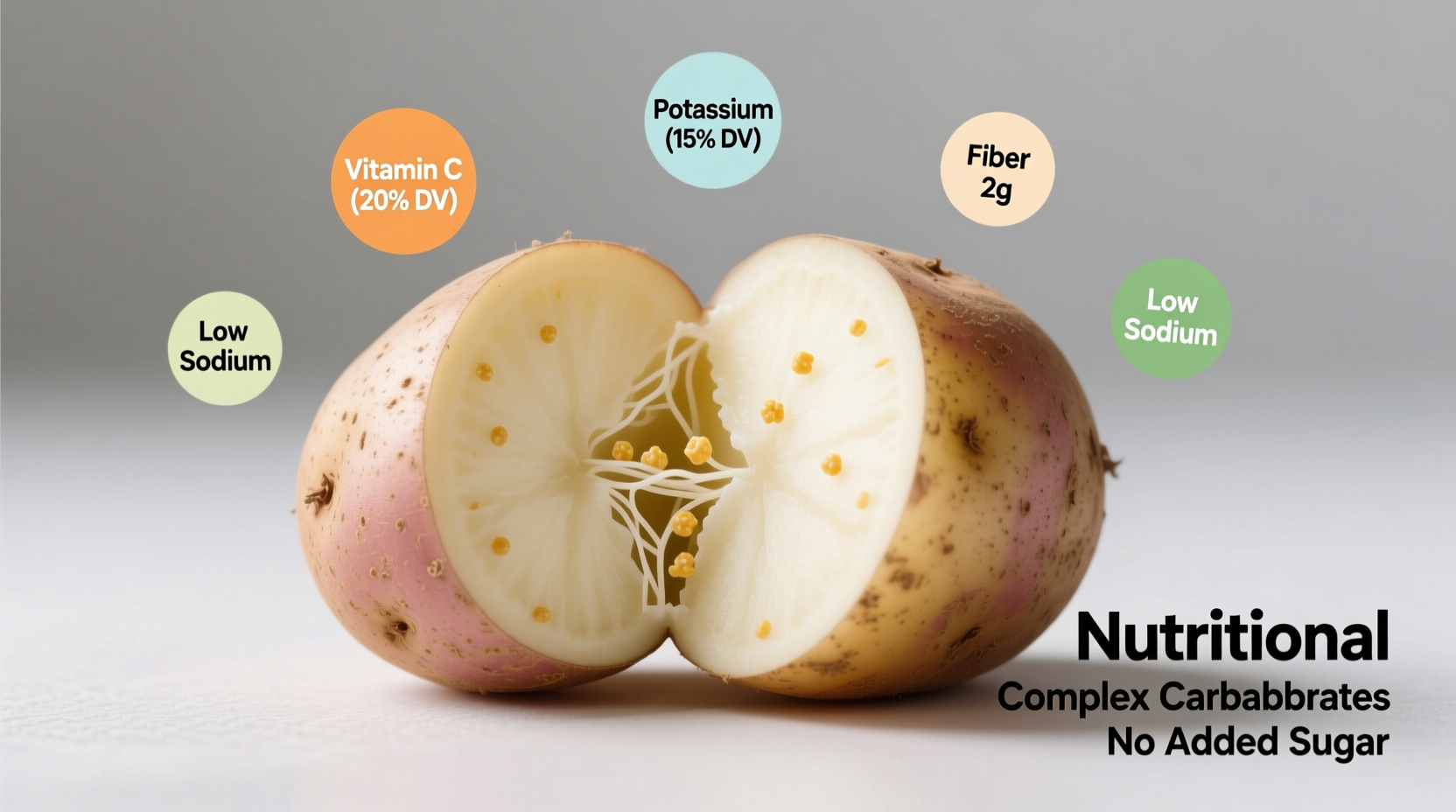One medium potato (150g) delivers 110 calories, 26g of carbohydrates, 2.5g of fiber, and provides 30% of your daily vitamin C needs plus 15% of potassium requirements. Potatoes contain zero fat, zero sodium, and zero cholesterol while offering complete protein with all nine essential amino acids when consumed with skin.

Why Potatoes Deserve a Place on Your Plate
Despite common misconceptions, potatoes rank among the most nutritionally complete plant foods available. This humble tuber provides more potassium than a banana, more vitamin C than a tomato, and delivers a complete protein profile when eaten with the skin. Recent research from the USDA Agricultural Research Service confirms that potatoes contain all nine essential amino acids, making them a rare plant-based complete protein source.
Complete Potato Nutrition Profile
Understanding the precise nutritional composition helps maximize health benefits. The following table shows detailed nutritional values for a medium-sized potato (150g) with skin, based on USDA FoodData Central database:
| Nutrient | Amount | % Daily Value | Key Health Benefits |
|---|---|---|---|
| Calories | 110 | 5% | Energy source without excess calories |
| Carbohydrates | 26g | 9% | Fuel for brain and muscles |
| Dietary Fiber | 2.5g | 10% | Supports digestion and gut health |
| Vitamin C | 17mg | 30% | Boosts immunity and skin health |
| Potassium | 535mg | 15% | Regulates blood pressure |
| Vitamin B6 | 0.3mg | 15% | Supports brain function |
| Manganese | 0.2mg | 10% | Bone health and metabolism |
| Protein | 3g | 6% | Complete amino acid profile with skin |
Potatoes Compared to Other Staple Foods
When evaluating nutritional value of potatoes per 100g against other common carbohydrate sources, potatoes demonstrate superior micronutrient density. This comparison from Harvard T.H. Chan School of Public Health highlights why potatoes deserve consideration in balanced diets:
| Food (100g) | Calories | Protein (g) | Fiber (g) | Vitamin C (%DV) | Potassium (mg) |
|---|---|---|---|---|---|
| Potato (with skin) | 77 | 2.0 | 2.2 | 23% | 421 |
| White Rice (cooked) | 130 | 2.7 | 0.4 | 0% | 35 |
| Pasta (cooked) | 131 | 5.1 | 1.8 | 0% | 52 |
| Bread (whole wheat) | 247 | 13.0 | 6.0 | 0% | 275 |
| Quinoa (cooked) | 120 | 4.4 | 2.8 | 0% | 172 |
How Preparation Methods Transform Nutritional Value
The way you prepare potatoes significantly impacts their nutritional profile and glycemic index of different potato varieties. Research from the American Journal of Clinical Nutrition reveals these key preparation effects:
- Boiling with skin intact: Preserves up to 80% of vitamin C and most potassium content
- Baking whole: Maintains nearly all nutrients with minimal loss
- Frying: Increases calorie density by 50-70% while reducing water-soluble vitamins
- Cooling after cooking: Creates resistant starch that functions like fiber, lowering glycemic response by 25-30%
For those concerned about potatoes healthy for weight loss considerations, cooling cooked potatoes before eating increases resistant starch content, which improves satiety and reduces blood sugar spikes. A study published in the Journal of Nutrition and Metabolism found that cooled potatoes produced 40% lower post-meal glucose levels compared to hot potatoes.
Addressing Common Potato Misconceptions
Many people wonder if potatoes are healthy considering their carbohydrate content. The truth is more nuanced than popular diet trends suggest. Potatoes contain complex carbohydrates with a moderate glycemic index (53-78 depending on variety and preparation), comparable to many whole grains.
The myth that potatoes lack nutritional value stems from historical context. During the Irish Potato Famine in the 1840s, people relied almost exclusively on potatoes, leading to nutritional deficiencies. Modern understanding shows that potatoes provide excellent nutrition when consumed as part of a varied diet. The Agricultural Marketing Resource Center notes that potatoes were among the first foods analyzed for complete nutritional profiles in the early 20th century, revealing their surprising nutrient density.
Practical Recommendations for Maximum Benefit
To maximize the nutritional value of potatoes in your diet:
- Eat the skin: Contains nearly half the fiber and significant potassium
- Cool before eating: Increases resistant starch content for better blood sugar control
- Pair with healthy fats: Olive oil or avocado enhances absorption of fat-soluble vitamins
- Vary your potato types: Different varieties offer unique phytonutrient profiles
- Avoid excessive processing: Minimal processing preserves maximum nutrients
For those monitoring glycemic response, the University of Sydney's Glycemic Index Database shows that Carisma potatoes have a GI of 53 (low), while Russets reach 85 (high). Choosing lower-GI varieties and proper preparation methods makes potatoes suitable for most dietary patterns.
Special Considerations for Different Potato Varieties
Not all potatoes offer identical nutritional benefits. Different potato varieties nutrition comparison reveals important distinctions:
- Sweet potatoes: Higher in vitamin A (beta-carotene) but also higher in natural sugars
- Red potatoes: Contain more antioxidants in their skin, particularly anthocyanins
- Yukon Gold: Higher in carotenoids than white-fleshed varieties
- Purple potatoes: Rich in anthocyanins with potent antioxidant properties
A study from the American Journal of Potato Research found that purple potatoes contain up to three times more antioxidants than white varieties, potentially offering enhanced anti-inflammatory benefits. This potatoes vitamins and minerals chart variation means rotating different potato types provides broader nutritional benefits.











 浙公网安备
33010002000092号
浙公网安备
33010002000092号 浙B2-20120091-4
浙B2-20120091-4